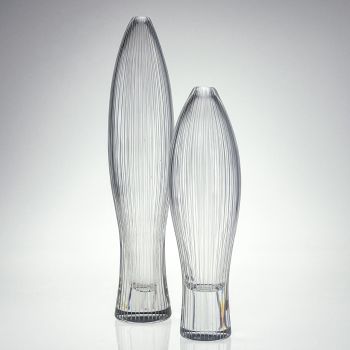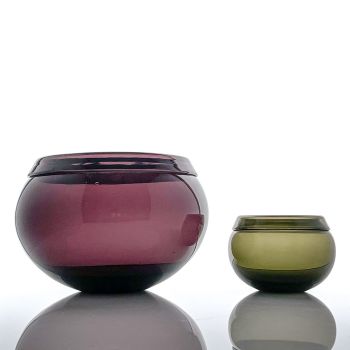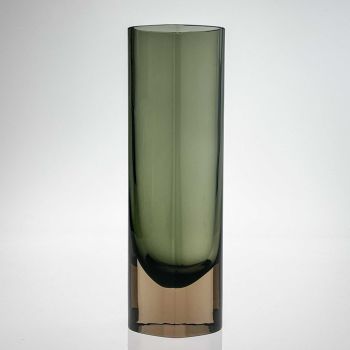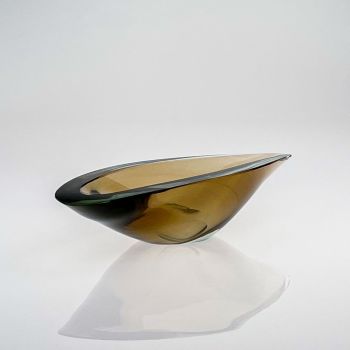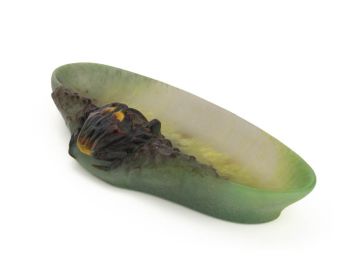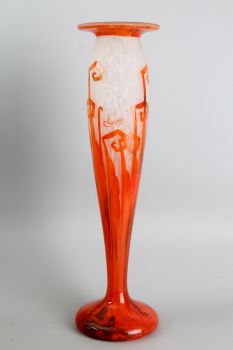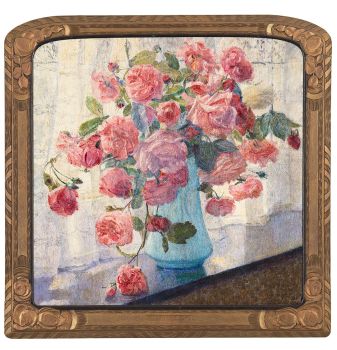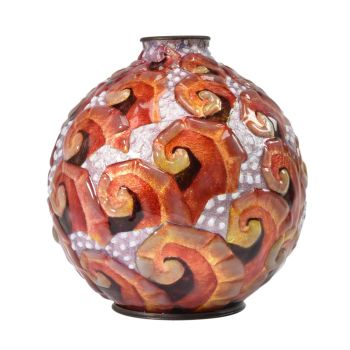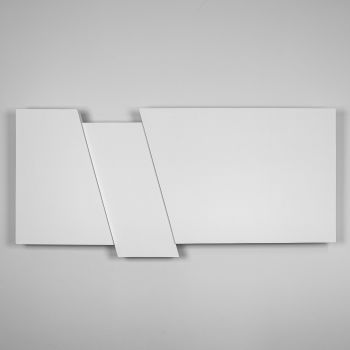Glass art-object, model 531.1M – Venini, Italy circa 1970 1970 - 1979
Tapio Wirkkala
Vidrio
14 cm, ø 31 cm
ConditionGood
€ 2.000
Van Kerkhoff Art
- Sobre la obra de arteA capital art-object/bowl, model 531.1M, crafted in striking freeblown blue (aquamerine), pale yellow (pagliesco) and black (dark amathist) glass. Designed by the renowned Tapio Wirkkala in 1970, this rare piece was brought to life by the skilled craftsmen of the Venini glassworks on the picturesque Island of Murano in Venice in the 1970's.
This particular object was made using Incalmo, copper wire inclusion and freeblown glass. The copper wire mesh from a distance gives the surface the impression of feathers. The base is formed using pale yellow glass with a black inserted centre. Underneath the black circle the bowl is signed in diamondpen: Venini Italia TW.
About Tapio Wirkkala
Tapio Wirkkala (1915 Hanko, Finland – 1985 Helsinki, Finland) A giant of Finnish design, possessed an extraordinary creative spirit that knew no boundaries. His artistic repertoire traversed diverse materials and transcended conventional design disciplines, leaving an indelible mark on the world of art and craftsmanship.
The trajectory of Wirkkala’s illustrious career was set in motion by a momentous glass design competition held by the revered Iittala glassworks in 1946. It was during this transformative event that Wirkkala, alongside the esteemed Kaj Franck, emerged as the joint recipients of the first prize. This recognition propelled Wirkkala into the spotlight, setting the stage for his remarkable artistic journey.
Wirkkala’s creative genius knew no bounds. His oeuvre spanned a vast spectrum, encompassing exceptionally beautiful glass art pieces, innovative industrial designs such as beer bottles and banknotes, meticulously crafted jewelry, evocative sculptures, and thoughtfully designed furniture. Each creation bore the unmistakable imprint of Wirkkala’s artistic prowess, showcasing his mastery over form, function, and aesthetics.
Throughout his illustrious career, Wirkkala amassed a multitude of accolades, honorary titles, and a doctorate, cementing his position as one of the most revered figures in the design world. His remarkable achievements include three Grand Prix medals at the prestigious Milan Triennale in 1954, followed by yet another Grand Prix medal and gold medal at the Milan Triennale in 1960. These prestigious awards not only celebrated Wirkkala’s unrivaled talent but also underscored his profound impact on the global design landscape.
Wirkkala’s creative journey was an embodiment of innovation, pushing the boundaries of design and challenging conventional norms. His unparalleled ability to infuse beauty into everyday objects and elevate them to the realm of art garnered admiration and acclaim from enthusiasts and experts alike.
Today, we celebrate Tapio Wirkkala as a visionary pioneer who seamlessly merged artistry with functionality. His enduring legacy serves as a testament to the limitless possibilities of design, inspiring generations of artists and designers to think beyond the confines of tradition and embrace their creative instincts.
Marked
Signed underneath the base: Venini Italia TW (Tapio Wirkkala)
Execution
Venini, Murano 1970's
Condition
Good vintage condition, no chips or cracks. Schratches on the side and underneath the base. Inclusion in the side.
Literature
Marianne Aav, Tapio Wirkkala eye, hand and thought: p. 335
Marino Barovier and Carla Sonego (ed.), Tapio Wirkkala at Venini, p.233
Dimensions
Height 14 cm
Diameter 31 cm
Weight 1999 grams - Sobre el artista
Tapio Wirkkala (1915-1985) fue un genio del diseño con múltiples talentos, ampliamente considerado una figura destacada del arte industrial finlandés moderno. La amplia cartera de Wirkkala abarca desde vidrio, muebles y diseño de productos hasta escultura, planificación urbana, arte, gráficos e incluso la creación de billetes para el tesoro finlandés.
A lo largo de su carrera increíblemente productiva, Wirkkala recibió numerosos premios, incluidas tres medallas de oro en la Trienal de Milán, el Premio Lunning, la Medalla Pro Finlandia y la Medalla Príncipe Eugen.
En 1946, Wirkkala ganó su primer premio de diseño en un concurso patrocinado por Iittala que marcaría una relación de por vida con efectos duraderos en su carrera y en la empresa. Como director artístico de Iittala, la visión artística única de Wirkkala ayudó a establecer la reputación global de la empresa.
A lo largo de su legendaria carrera, el artista de talento único creó más de cuatrocientos objetos de vidrio para Iittala, muchos de los cuales, como las series Ultima Thule y Tapio, siguen siendo populares en la actualidad.
¿Está interesado en comprar esta obra de arte?
Artwork details
Related artworks
- 1 - 4 / 8
Børge Mogensen
Teak wood “dropleaf” desk – Søborg Møbler, Denmark circa 19551950 - 1960
Prijs op aanvraagVan Kerkhoff Art
1 - 4 / 24Johann Loetz (Lötz) Witwe Klostermühle
Johann Loetz Witwe – Ausfuehrung 146 Titania vase – 19121910 - 1919
Prijs op aanvraagAntiques Emporium
Amalric Walter
Amalric Walter & Henri Bergé – Crabe plumier1920 - 1929
Prijs op aanvraagAntiques Emporium
Onbekende Kunstenaar
François-Théodore Legras – Tall “Fleurs de Pommier” apple blossoms vase1900 - 1909
Prijs op aanvraagAntiques Emporium
Demetre Chiparus
Demetre H. Chiparus – Bronze Art Deco statue “Rapture” – Édition Etling, Paris1920 - 1929
Prijs op aanvraagAntiques Emporium
1 - 4 / 24Rudolf de Bruyn Ouboter
Still life with red bowl, blue salt cellar, weck jar and Japanese print1940 - 1960
Prijs op aanvraagAdelwein Kunst
Jan Voerman sr
Stilleven met bloemen in een Chinees beeldje1850 - 1900
Prijs op aanvraagKunsthandel Pygmalion
1 - 4 / 24Johann Loetz (Lötz) Witwe Klostermühle
Johann Loetz Witwe - Phänomen Genre 7773 – Orange1900 - 1910
Prijs op aanvraagAntiques Emporium
1 - 4 / 24- 1 - 4 / 12











